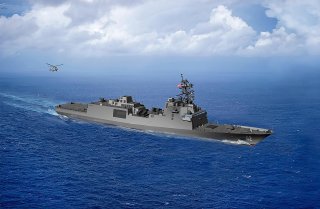The U.S. Navy Wants More 15 New Next-Gen Frigates
The Fincantieri Marinette Marine-engineered frigate has taken on more of its own developmental trajectory to incorporate both littoral kinds of maritime warfare capabilities as well as “open” or “blue water” combat potential.
The Navy is surging forward with its new ambitious plan to produce as many as fifteen new frigates within the next five years. Alongside that development, the military service’s plans for weapons and technology integration are taking shape. It is clear the Navy intends to architect this ship in what could be referred to as a dual-attack capacity, which means the ship will be built for both littoral warfare and “blue water” warfare on the open sea. Some of the technological indications, now being refined by the Navy through simulation, are showing great promise that such an approach is indeed achievable.
While initially being conceived as an up-gunned Littoral Combat Ship (LCS), or more survivable LCS-type platform, the Fincantieri Marinette Marine-engineered frigate has taken on more of its own developmental trajectory to incorporate both littoral kinds of maritime warfare capabilities as well as “open” or “blue water” combat potential. For instance, initial plans for the frigate years ago were not clear or certain that the ship would integrate missile-launching Vertical Launch Systems (VLS), yet the current ship under development will include as many as thirty-two VLS, Capt. Kevin Smith, the program manager of the Constellation-class frigate, told an audience at the Navy League’s Sea Air Space Symposium.
This will require the engineering of a well-crafted technological interface between the VLS fire-control systems and shipboard Aegis Radar, Smith further elaborated. Making the ship Aegis radar-capable—particularly with the inclusion of the most advanced Baseline 10 configuration—massively increases an air and cruise missile defense capability which is merged into a ballistic missile defense capability. Most U.S. Navy destroyers and cruisers are Aegis-capable, a technological capacity that actually greatly fortifies an ability to track and destroy a wide range of missile threats. An Aegis-empowered defensive ability includes countering anti-ship missiles and even intercontinental ballistic missiles closing in on the earth’s atmosphere in the terminal phase with a newly configured longer-range, larger SM-3 Block IIA interceptor weapon.
Success for a mission of this kind relies to a great degree on synergizing, merging and integrating Aegis fire control systems with a Raytheon-produced Enterprise Air Surveillance Radar (EASR), Smith explained.
“We are trying to burn down all the risk we can with Aegis integration with the EASR radar,” Smith said. “We are working now on making those kinds of investments. You cannot throw away any kind of integration. If there is an opportunity to burn down risk, you have to take it. We don’t want to have this introduced on the waterfront.”
These types of attributes certainly could help defend against any kind of incoming land-launched ballistic missile or anti-ship missiles. The ship is also armed with a Raytheon-Kongsberg weapon called the Naval Strike Missile, a Raytheon Rolling Airframe Missile for closer-in shipboard defenses and attack and of course an ability to launch longer-range, highly precise SM-3 missiles, SM-6 missiles and Tomahawk missiles, Smith explained.
However, despite this heavy firepower, the frigate is by no means intended to merely replicate a U.S. Navy cruiser or destroyer as it is engineered with multi-functional, LCS-like anti-submarine and surface warfare systems. These attributes, combined with a more shallow draft when compared with deeper draft cruisers and destroyers, will enable the frigate to successfully engage in more littoral missions such as coastal patrol or land attack. The ability to fire a long-range Tomahawk missile capable of flying nine hundred nautical miles from locations closer to shore opens up new target possibilities for Navy ships looking to strike very far inland targets less accessible from farther ranges.
These attributes combined with electronic warfare, cyber and possibly even laser weapons, are intended to enable a kind of “hybrid” mission set for the ship to include land attack, countermine missions, anti-submarine warfare as well as “over-the-horizon” missile technology. In essence, the ship is heavy enough to support and operate in a heavy, great-power warfare environment yet also more versatile than a destroyer in that it can maneuver closer to shore and offer a kind of medium, dual-pronged option for commanders.
Kris Osborn is the defense editor for the National Interest. Osborn previously served at the Pentagon as a Highly Qualified Expert with the Office of the Assistant Secretary of the Army—Acquisition, Logistics & Technology. Osborn has also worked as an anchor and on-air military specialist at national TV networks. He has appeared as a guest military expert on Fox News, MSNBC, The Military Channel, and The History Channel. He also has a Master's Degree in Comparative Literature from Columbia University. This article first appeared earlier this year.
Image: Reuters

